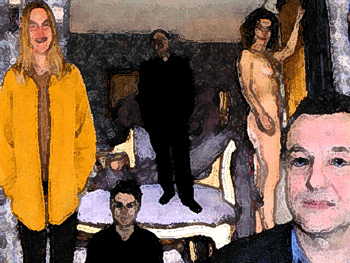|
The room is arranged as a waiting-hall like the one you can find in an airport. A quasi cozy line-up with a green island at the end of the space. This island is made up of around 20 marsh-plants with white flowers which are able to endure darkness. This plant, called Spathifhillum, is a normal encounter in lobbies. The rows of chairs are placed in a geometric pattern consisting of straight lines and angels with small wooden tables in between. Some chairs are clothed with panties and aprons. This arrangement doesnÝt directly facilitate social contact, and makes it possible for the audience to witness the performance in relative anonymity.
The placement of some active spots in the room does however encourage human traffic. A bar in in one of the corners serves drinks. In an other corner stands a table full of mugs with ice-water. On the way going there you pass a model of a new neighbourhood built from remnant wood and sand. Both in Amsterdam and Rotterdam this were models of the new neighbourhoods now under construction in the old harbours. In addition to this, small reading-tables offer colourful magazines in different languages. The performance consists of 6 parts indicated by capital letters: part A, B, C, D, E and F. Between every part there is a small break with the duration of an average pop-song; 3 minutes 40 seconds. During these breaks, jazz-CDÝs are played. The different parts have lengths varying from 6 to 16 minutes. By throwing dices, a different order is made for every performance. According to this order, the light-computer is programmed with the light-positions for every part with the intermission-light in between. The light-positions have different names like Potato, Negative Potato, Small runways and Green field. The light-programme runs automatically. The changes in the light appear suddenly and do not always coincide with the beginning of the next break. After each break the performers start when the light changes to the next position; the audience and the performers, scattered around the room as a result of the break, sit down again or start to play. During the first break the audience are told about the order of tonightÝs performance, and also about the previous one. The different spots in the room are explained and it is told that the green carpet is placed in the direction of the closest airport. In Amsterdam, this was Schiphol, in Rotterdam, Zestienhoven and in Arnhem, Terval. The room is intersected by two, oblique with each other, empty runways. One is a green carpet, 7 meters long and 2 meters wide, directed towards the closest airport with the use of maps and compass. The other runway crosses this green in the middle and ends in a bar. At both endpoints of this runway, green plants are standing. This runway is shaped by making a hole in the pattern of chairs, and is also lit in one of the light-positions. The performers move throughout the whole room in this Singdance-performance while talking, singing and dancing on music. The parts have different characteristics and atmospheres based on various sorts of catastrophes, accidents and failures. The texts have titles like Tsunami, a Japanese word meaning shock-waves in the sea, Explosion and The cancer. But also The story of the ass, Hotel-room, Coffie-call and ErikÝs cheese-dream. The songs are titled The crash, Little ass and Airport-song. Part A consists of the sonnet-cycle ŰBefore daybreakÝ from 1936 by Martinus Nijhoff with an introduction by Tom Jansen. In these sonnets, sketches of eight human characters are made based on their behaviour at the break of dawn. The faith in progress is strong in these modern poems, but the knowledge of the coming war, makes characters as the tram-driver and the little girl who combs her hair extra fragile. The different parts vary in intensity, and the different fragments in each part are put together according to their musicality and rhythm. The music is based on patterns and ways of composing derivated from the New York architectural grid, but also from a commercial march from the beginning of this century, and the Coffie-cantata from J.S.Bach. The sounds used are derived from different pieces of wood, a variety of string-instruments and air planes. The music is played live with a sampler, computer, synthesiser, effectmachine, guitars and saxophone. The projection of the sound varies in each part with changing positions of the boxes. The room is open for the audience, performers and other random visitors half an hour before the beginning of the performance, and stays open a while after the active part, which lasts approximately 1 hour and 30 minutes.
|
|
